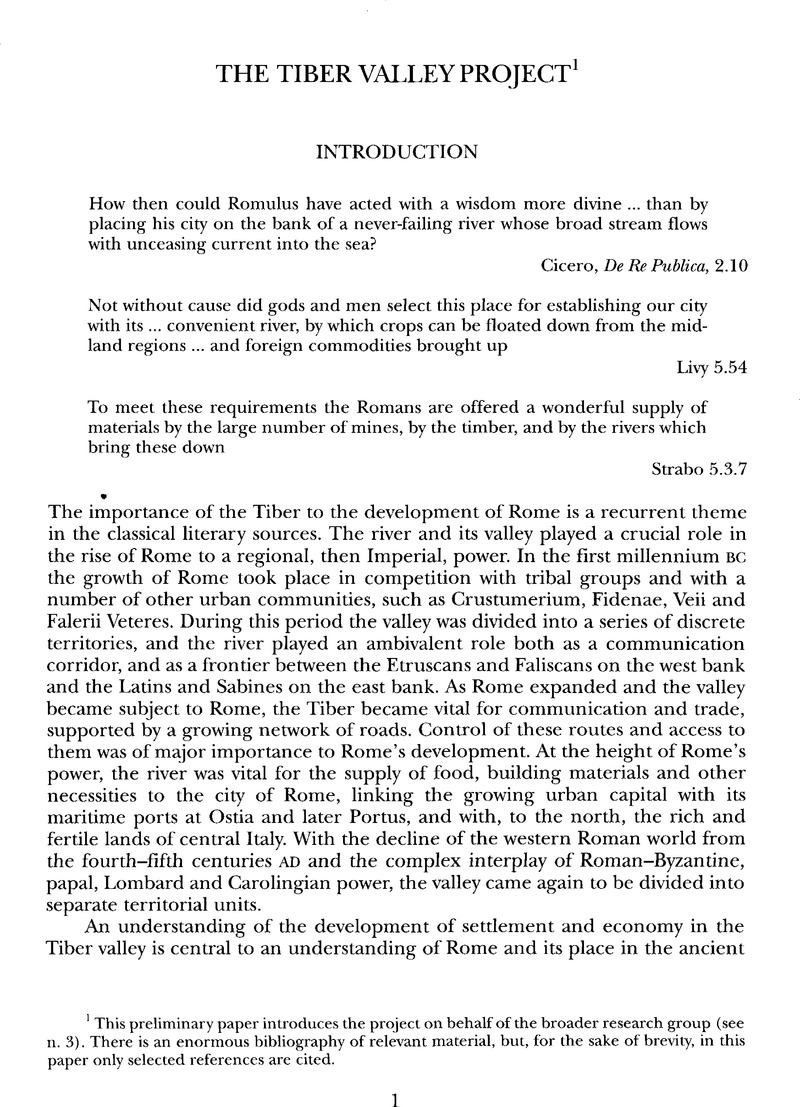Crossref Citations
This article has been cited by the following publications. This list is generated based on data provided by Crossref.
Keay, Simon
Millett, Martin
Poppy, Sarah
Robinson, Julia
Taylor, Jeremy
and
Terrenato, Nicola
2000.
Falerii Novi: a new survey of the walled area.
Papers of the British School at Rome,
Vol. 68,
Issue. ,
p.
1.
Patterson, H.
di Gennaro, F.
di Giuseppe, H.
Fontana, S.
Gaffney, V.
Harrison, A.
Keay, S. J.
Millett, M.
Rendeli, M.
Roberts, P.
Stoddart, S.
and
Witcher, R.
2000.
The Tiber Valley Project: the Tiber and Rome through two millennia.
Antiquity,
Vol. 74,
Issue. 284,
p.
395.
Potter, T. W.
and
Stoddart, Simon
2001.
A century of prehistory and landscape studies at the British School at Rome.
Papers of the British School at Rome,
Vol. 69,
Issue. ,
p.
3.
di Giuseppe, Helga
Sansoni, Marta
Williams, John
and
Witcher, Robert
2002.
The Sabinensis Ager revisited: a field survey in the Sabina Tiberina.
Papers of the British School at Rome,
Vol. 70,
Issue. ,
p.
99.
Johnson, Paul
Keay, Simon
and
Millett, Martin
2004.
Lesser urban sites in the Tiber valley: Baccanae, Forum Cassii and Castellum Amerinum.
Papers of the British School at Rome,
Vol. 72,
Issue. ,
p.
69.
Patterson, Helen
Di Giuseppe, Helga
and
Witcher, Rob
2004.
Three South Etrurian ‘crises’: first results of the Tiber Valley Project.
Papers of the British School at Rome,
Vol. 72,
Issue. ,
p.
1.
Gaffney, V.
Patterson, H.
Piro, S.
Goodman, D.
and
Nishimura, Y.
2004.
Multimethodological approach to study and characterize Forum Novum (Vescovio, central Italy).
Archaeological Prospection,
Vol. 11,
Issue. 4,
p.
201.
Galaty, Michael L.
2005.
European Regional Studies: A Coming of Age?.
Journal of Archaeological Research,
Vol. 13,
Issue. 4,
p.
291.
Di Giuseppe, Helga
2005.
Un confronto tra l'etruria settentrionale e meridionale dal punto di vista della ceramica a vernice nera.
Papers of the British School at Rome,
Vol. 73,
Issue. ,
p.
31.
Keay, Simon
Millett, Martin
and
Strutt, Kristian
2006.
An archaeological survey of Capena (La Civitucola, provincia di Roma).
Papers of the British School at Rome,
Vol. 74,
Issue. ,
p.
73.
Carlucci, Claudia
De Lucia Brolli, Maria Anna
Keay, Simon
Millett, Martin
and
Strutt, Kristian
2007.
An archaeological survey of the Faliscan settlement at Vignale, Falerii Veteres (province of Viterbo).
Papers of the British School at Rome,
Vol. 75,
Issue. ,
p.
39.
Rajala, Ulla
2007.
The bronze and iron age finds from Il Pizzo (Nepi, Vt): the results of the intensive survey in 2000.
Papers of the British School at Rome,
Vol. 75,
Issue. ,
p.
1.
Hay, Sophie
Johnson, Paul
Keay, Simon
and
Millett, Martin
2010.
Falerii Novi: further survey of the northern extramural area.
Papers of the British School at Rome,
Vol. 78,
Issue. ,
p.
1.
Mills, Philip
and
Rajala, Ulla
2011.
THE ROMAN CERAMIC MATERIAL FROM FIELD WALKING IN THE ENVIRONS OF NEPI.
Papers of the British School at Rome,
Vol. 79,
Issue. ,
p.
147.
Rajala, Ulla
2013.
The concentration and centralization of late prehistoric settlement in central Italy: the evidence from the Nepi Survey.
Papers of the British School at Rome,
Vol. 81,
Issue. ,
p.
1.
Keay, Simon
and
Millett, Martin
2016.
A Companion to Roman Italy.
p.
355.
Palmisano, Alessio
Bevan, Andrew
and
Shennan, Stephen
2018.
Regional Demographic Trends and Settlement Patterns in Central Italy: Archaeological Sites and Radiocarbon Dates.
Journal of Open Archaeology Data,
Vol. 6,
Issue. ,
Desibio, Luca
2020.
Il Tevere come frontiera tra Umbria ed Etruria.
Mélanges de l'École française de Rome. Antiquité,
p.
17.
Stoddart, Simon
2020.
Power and Place in Etruria.
Fulminante, Francesca
and
Alessandri, Luca
2024.
Salt Production in Central Italy and Social Network Analysis Centrality Measures: An Exploratory Approach.
Open Archaeology,
Vol. 10,
Issue. 1,



